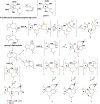New Formyl Phloroglucinol Meroterpenoids from the Leaves of Eucalyptus robusta
- PMID: 28004790
- PMCID: PMC5177953
- DOI: 10.1038/srep39815
New Formyl Phloroglucinol Meroterpenoids from the Leaves of Eucalyptus robusta
Abstract
Seven new formyl phloroglucinol meroterpenoids (FPMs), namely eucalrobusones J-P (1-7), as well as three known ones (8-10) were isolated from the leaves of Eucalyptus robusta. Their structures were elucidated by spectroscopic data analysis, and their absolute configurations were determined by applications of the Snatzke's helicity rule and the electron circular dichroism (ECD) calculation. These FPMs are diverse in coupling patterns between phloroglucinol and sesquiterpenoid units, forming novel polycyclic ring systems. Compound 1 possesses a new carbon skeleton that a 1-oxaspiro[5.6]dodecane core is formed through C-14 rather than C-4 of the aromadendrane moiety. Compound 2 features a novel 6/7/5 ring-fused 6-oxabicyclo[3.2.2]nonane skeleton. Compounds 3-5 are rare aristolane-based FPMs. By forming different oxo bridges, compound 3 is the first sample of FPM with benzo-dihydrofuran structure, and compound 4 possesses a novel 6/6/6/6/3-fused pentacyclic skeleton. Compounds 1, 6, and 8 exhibited significant antifungal activities against Candida glabrata with MIC50 values of 2.57, 1.95, and 2.49 μg/mL, respectively.
Figures







Similar articles
-
Twelve formyl phloroglucinol meroterpenoids from the leaves of Eucalyptus robusta.Phytochemistry. 2019 Jul;163:111-117. doi: 10.1016/j.phytochem.2019.04.008. Epub 2019 Apr 30. Phytochemistry. 2019. PMID: 31039475
-
(1) H NMR-Guided Isolation of Formyl-Phloroglucinol Meroterpenoids from the Leaves of Eucalyptus robusta.Chemistry. 2016 Aug 8;22(33):11778-84. doi: 10.1002/chem.201601732. Epub 2016 Jul 14. Chemistry. 2016. PMID: 27412352
-
Eurobusones A-D, four antibacterial formyl phloroglucinol meoterpenoids from Eucalyptus robusta.Fitoterapia. 2022 Mar;157:105131. doi: 10.1016/j.fitote.2022.105131. Epub 2022 Jan 31. Fitoterapia. 2022. PMID: 35093480
-
Structural Diversity of Complex Phloroglucinol Derivatives from Eucalyptus Species.Chem Biodivers. 2022 Jun;19(6):e202200025. doi: 10.1002/cbdv.202200025. Epub 2022 May 27. Chem Biodivers. 2022. PMID: 35621714 Review.
-
Spicatulides A-G, Phenolic-Monoterpenoid Hybrids from Chloranthus spicatus.J Nat Prod. 2022 Aug 26;85(8):2090-2099. doi: 10.1021/acs.jnatprod.2c00546. Epub 2022 Aug 11. J Nat Prod. 2022. PMID: 35957573 Review.
Cited by
-
Phloroglucinol Mediated Plant Regeneration of Ornithogalum dubium as the Sole "Hormone-Like Supplement" in Plant Tissue Culture Long-Term Experiments.Plants (Basel). 2020 Jul 23;9(8):929. doi: 10.3390/plants9080929. Plants (Basel). 2020. PMID: 32717803 Free PMC article.
-
Eucalyptusdimers A-C, Dimeric Phloroglucinol-Phellandrene Meroterpenoids from Eucalyptus robusta.Org Lett. 2018 Aug 17;20(16):5066-5070. doi: 10.1021/acs.orglett.8b02259. Epub 2018 Aug 8. Org Lett. 2018. PMID: 30088934 Free PMC article.
-
Prodigious biodegradation of polycyclic aromatic fluorene with manganese oxide nanoparticles from Stenotrophomonas sp.Biodegradation. 2025 Aug 25;36(5):81. doi: 10.1007/s10532-025-10177-7. Biodegradation. 2025. PMID: 40853573
-
UPLC-PDA-Q Exactive Orbitrap-MS profiling of the lipophilic compounds product isolated from Eucalyptus viminalis plants.Heliyon. 2020 Dec 23;6(12):e05768. doi: 10.1016/j.heliyon.2020.e05768. eCollection 2020 Dec. Heliyon. 2020. PMID: 33385084 Free PMC article.
-
Meroterpenoids: A Comprehensive Update Insight on Structural Diversity and Biology.Biomolecules. 2021 Jun 29;11(7):957. doi: 10.3390/biom11070957. Biomolecules. 2021. PMID: 34209734 Free PMC article. Review.
References
-
- Nishizawa M. et al.. Macrocarpals: HIV-RTase inhibitors of Eucalyptus globulus. Tetrahedron Lett. 33, 2983–2986 (1992).
-
- Shou Q. Y. et al.. Rhodomyrtals A-D, four unusual phloroglucinol-sesquiterpene adducts from Rhodomyrtus psidioides. RSC Adv. 4, 13514–13517 (2014).
-
- Yang S. P. et al.. Potent HGF/c-Met axis inhibitors from Eucalyptus globulus: the coupling of phloroglucinol and sesquiterpenoid is essential for the activity. J. Med. Chem. 55, 8183–8187 (2012). - PubMed
-
- Tanaka T., Mikamiyama H., Maeda K. & Iwata C. Total synthesis of (−)-macrocarpal C. Stereoselective coupling reaction with a novel hexasubstituted benzene Cr(CO)3 complex as a biomimetic chiral benzyl cation equivalent. J. Org. Chem. 63, 9782–9793 (1998).
-
- Singh I. P., Sidana J., Bharatea S. B. & Foley W. J. Phloroglucinol compounds of natural origin: synthetic aspects. Nat. Prod. Rep. 27, 393–416 (2010). - PubMed
Publication types
MeSH terms
Substances
LinkOut - more resources
Full Text Sources
Other Literature Sources
Miscellaneous

